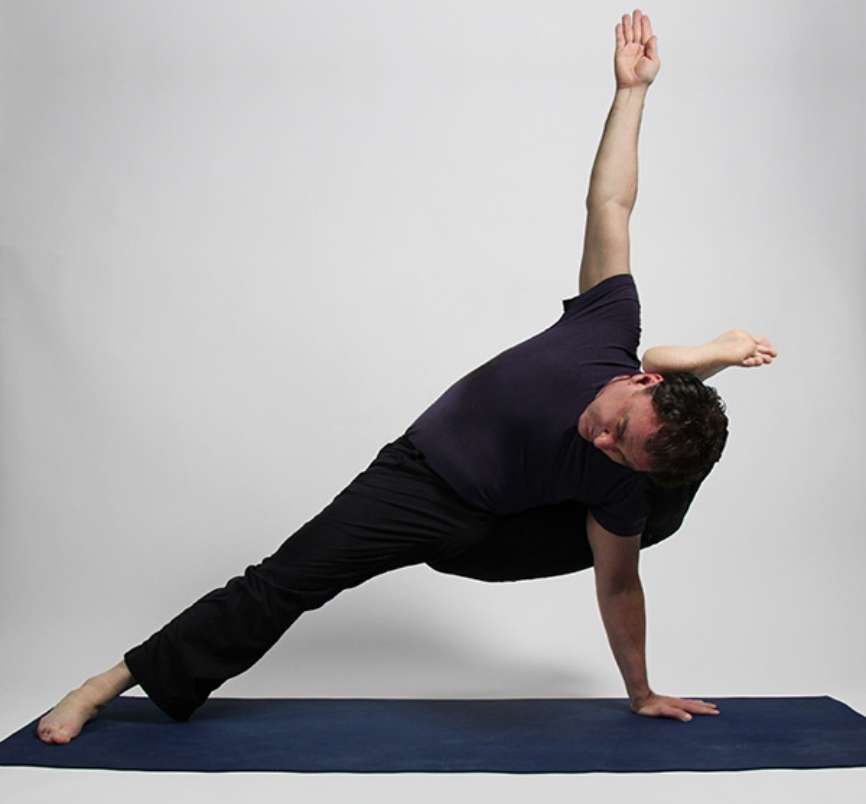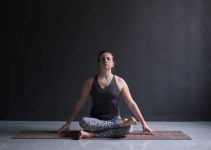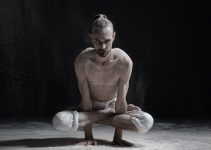
Bhairavasana is an advanced variation of Vasisthasana which intensely opens the hips while balancing the body on one hand and leg on the floor. It is a pose in the third series of Ashtanga yoga.
This pose involves side-bending and twisting of the torso stretching the arms, core, hamstrings, legs, and hips. Along with opening the hips, it opens a gateway towards immense strength and mental calmness.
Meaning and interpretation
Bhairavasana has been named after Lord Shiva’s fierce incarnation, known as Bhairav, who is associated with annihilation. Bhairav is known to destroy everything evil in nature, similarly, it eliminates all the negative forces like illusions, fears, ignorance, ego, attachment, bad habits, and everything that hinders true happiness.
Due to the annihilation principles of Bhairav, he is known as the destroyer of the Universe for enabling new creations. Hence, this pose is translated as Destroyer Of The Universe Pose. In Iyengar Yoga, it is referred to as Kala Bhairavasana.
Mythology behind Bhairavasana
There is a mythological tale behind the interpretation of this pose, which depicts a conversation between Lord Brahma and Vishnu. It goes something like that:
Once Lord Vishnu asked Brahma, “who is the greatest creator in this Universe.?” To which Brahma boldly replied, “it’s me of course, I have myself created this whole universe.” Brahma started thinking more and more about and his ego took over, as he started taking him as the supreme one.
It did not stop there, he had started interfering in Shiva’s duties and took over some of his charges too. This lead Shiva to Brahma’s newly developed pride about he being the supreme God and must be worshipped over as the almighty. This made Shiva angry and he decided to bring Brahma back to reality.
Shiva took his little fingernail and flicked it, from that his annihilation-related incarnation, Bhairav came into being. He found Brahma and chopped one of his five heads as a lesson. That’s why Brahma is depicted with only four heads now. To this, Brahma came to realize his arrogance, ego, and unnecessary pride and also bowed down to Shiva.
This explain the position of the leg behind the head while assuming Bhairavasana. It imitates that you are trying to behead yourself to not let the negative feelings get control over your mind and keeps the ego at bay.
Bhairavasana Practice Guide
This challenging pose demands certain precautionary measures and a lot of preliminary practices. Follow the given guidelines to assume bhairavasana with ease.
Contraindications of Bhairavasana
- Anyone with injury in and around the spine, hips, knee, neck shoulders, or wrist must avoid it.
- People suffering from a hernia must not try it out.
- Do not practice this pose if you have sciatica pain.
Preparatory Poses
- Wild thing pose (Camatkarasana)
- Side Plank Pose Crunch (Vasisthasana crunch)
- Side Plank Pose Arm Overhead (Vasisthasana variation)
- Seated Cradle (Hindolasana)
How to Do Bhairavasana (Steps)
- Begin in sitting in staff pose extending the legs in front.
- Bend your right leg at the knee and grab the foot with the left hand.
- Bring your right elbow under your right knee and raise the right knee a bit more upwards.
- Take the right knee behind the right shoulder and keep holding the right calf with the right hand.
- Slightly rotating the right hip, draw the right foot above your head.
- Further push the chest forward to place the right ankle behind the head.
- Inhale lengthening the spine and pressing the right palm and left foot on the floor, assume side plank on the right side.
- Raise the left arm up aligning the body diagonally from left heel to the crown.
- Turn your head up and gaze towards the left hand.
- Hold this pose for three to six long breaths.
- Come out of the pose by lowering the body, ducking the head forward, and pushing the abdomen in to release the right leg. Repeat it on the left side as well.
Here’s the demonstration of Bhairavasana in a vinyasa flow.
Follow-up Poses
- Sage Visvamitrasana Pose (Visvamitrasana)
- Patridge Pose (Kapinjalasana)
Bhairavasana Variation
There is one advanced level variation to this pose where the body undergoes similar moves but in a reclining position. It is better described below:
Supta Bhairavasana
- It is assumed by initiating in the staff pose. From there, the right leg is lifted to be kept over the right shoulder.
- With the left hand, pull the right leg towards the back of the head, here switch hands and support the right leg with the right hand behind the head. Lower the left elbow on the floor them lie down completely on your back with head resting over the right foot.
- Join your palms in prayer position in front of the chest
- The right leg remain lifted and left leg is extended with toes pointing to the floor.
Therapeutic Application
Bhairavasana is known to provide some therapeutic benefits as well. Let’s find out who can get its remedial effects in this section:
- People with high blood pressure, if practice this pose gets relieving effects.
- If you are struggling to get sound sleep, then turning to bhairavasana can serve as a boon to you, as it helps in curing insomnia.
- This challenging posture is practiced opening the chest and uplifts the respiratory system. It even helps to open the nasal passage and relieves sinusitis.
- Bhairavasana also stimulates the ovaries and uterus, hence it serves as a treatment for infertility.
- Menstrual discomforts, like irritation, leg and abdominal cramp are relieved practicing this pose.
- Improving the circulation of blood and oxygen, this pose benefits the brain by relieving anxiety, stress, and mental fatigue.
Bhairavasana Benefits
Bhairavasana provides several health benefits that flourish not only the body but also the mind. People need to try this must-do pose and get the following advantages out of it:
1. Promotes spinal flexibility
Practicing Bhairavasana lengthens the spine which stretches the back muscles and makes them supple and flexible. The spine gets strong and prevents any chances of getting hurt or injured.
2. Strengthens the leg muscles
It involves flexing the knees, ankles, while activating the arches and toes. It stretches the leg muscles and supplies blood and nourishment to the cells. Thus, promotes legs strength and flexibility.
3. Stimulates hip-flexors
Since, bhairavasana is an intense hip opener, it stretches the hip-flexors, and the internal rotation of the hips while performing the pose focuses on hip flexors. It improves the hip mobility and relieves all the accumulated stress.
4. Improves digestion
The abdominals are also stretched and massaged holding this posture. It tones the abdominal organs that aids in healthy digestion. Thus, it tones the abdominal muscles and keeps digestive disorders at bay.
5. Stretches Oblique muscles
To get into this pose, the torso is bent sideways that brings a great stretch in oblique muscles. It increases the endurance of these muscles, keeps the body toned and in proper shape.
6. Soothes the nervous system
Holding Bhairavasana brings a sense of surrender and acceptance. By bringing the sense of acceptance, it saves one from jealousy, anger, and frustration. Hence, it gives a chance to relieve the stress and fatigue, calms the mind, and brings internal peace.
Conclusion
Practice this typical and seemingly impossible pose and make yourself open to all the challenges. Also, on successful completion bhairavasana, you will develop an attitude of overcoming all the challenges, be it a combat of overcoming negative emotions.
Even after keeping the several physical benefits aside, the psychological benefits makes Bhairavasana as must to-do pose.




